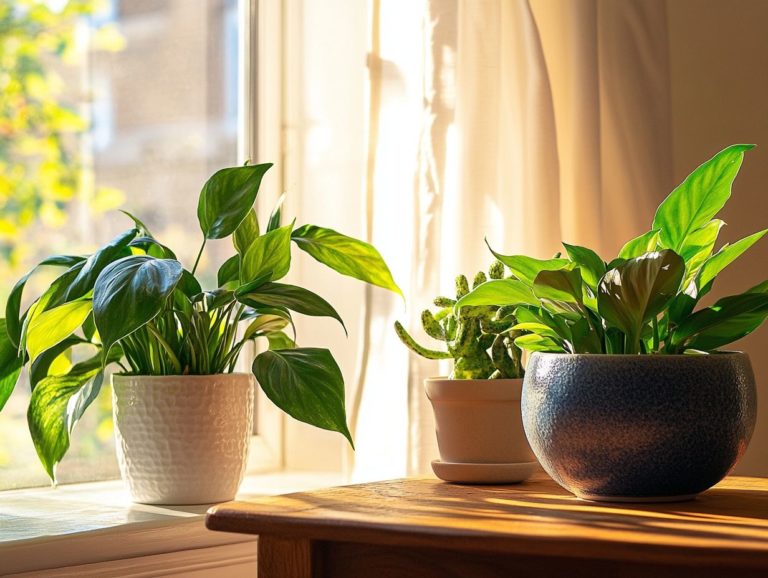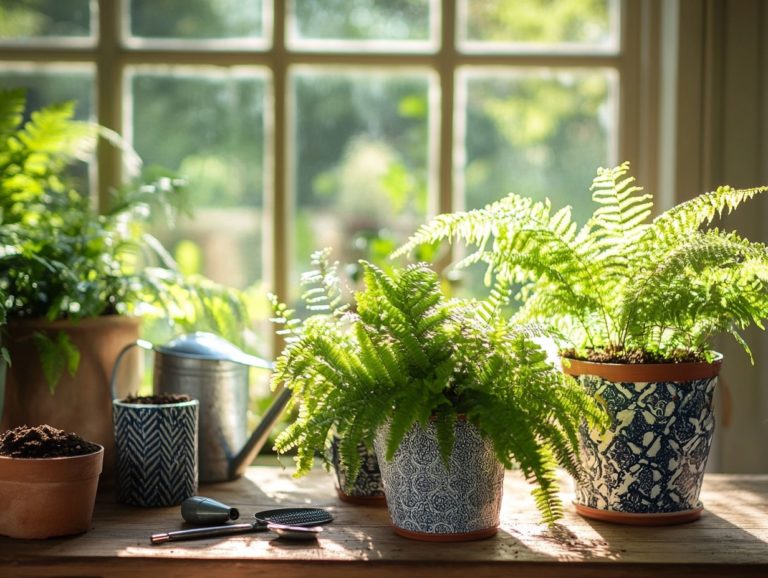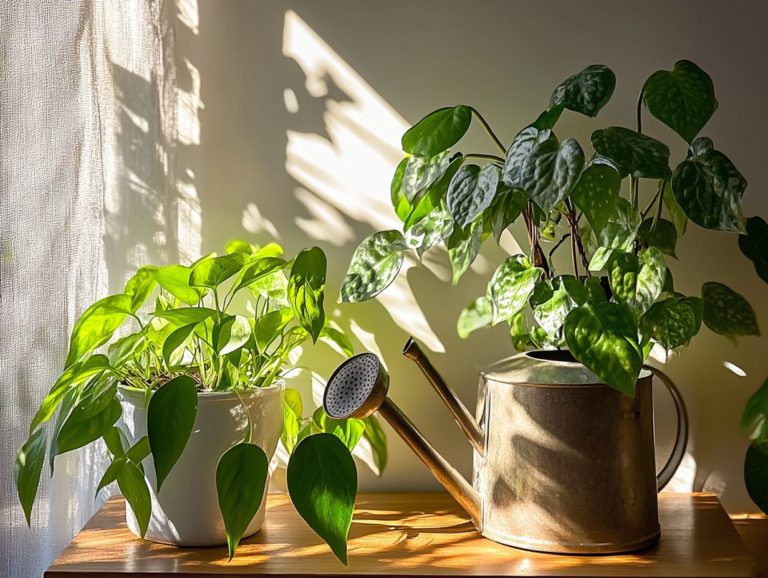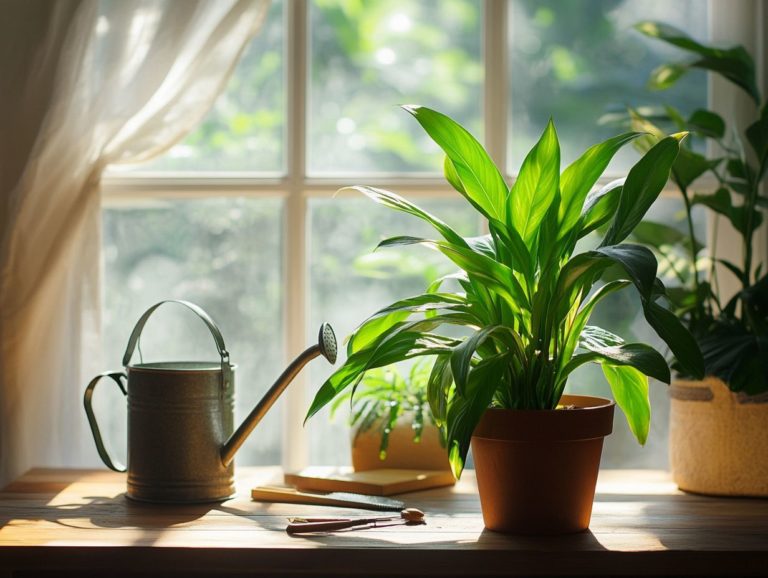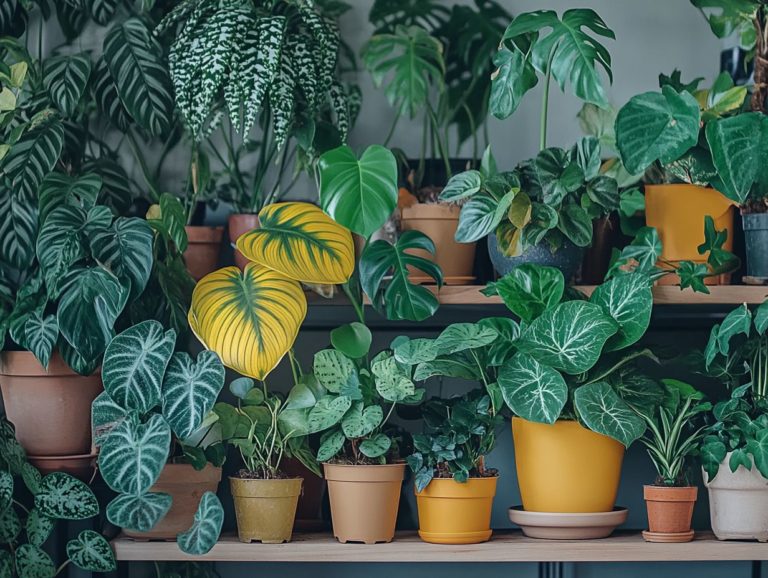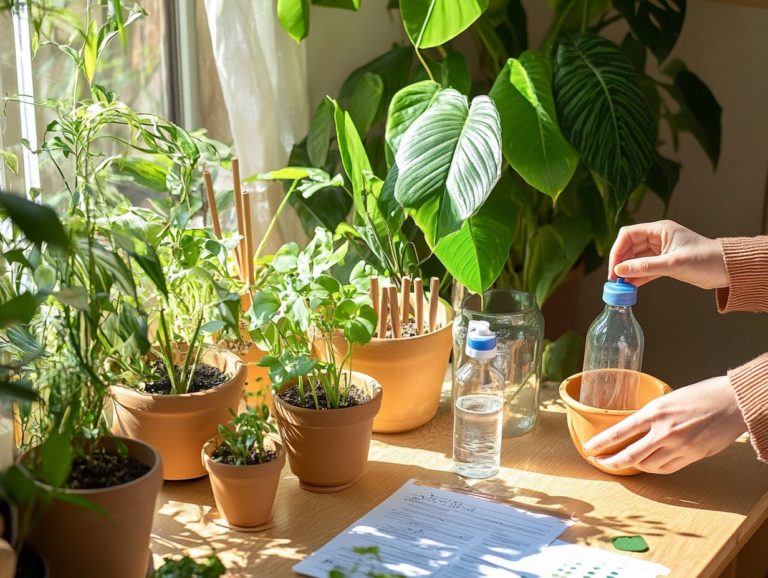How Do I Identify Indoor Plant Types?
Indoor plants, such as popular houseplants, have the power to transform your space, infusing life and beauty into your home.
With a plethora of plant varieties available, it can be a challenge to identify and grasp their unique needs. This article delves into the captivating realm of indoor plants, exploring various classification methods based on growth habits and light conditions.
Gain the skills to recognize plants by their appearance and understand their specific care requirements, including watering techniques and temperature control.
Uncover valuable resources for plant identification and care tips. Dive into the wonderful world of indoor gardening and discover how easy it can be to create your own green oasis!
Contents
- Key Takeaways:
- Understanding Different Types of Indoor Plants
- Identifying Indoor Plants by Appearance
- Identifying Indoor Plants by Care Needs
- Resources for Identifying Indoor Plants
- Frequently Asked Questions
- How Do I Identify Indoor Plant Types?
- What are some common characteristics to look for when identifying indoor plants?
- Can I identify indoor plant types based on their care needs?
- Are there any tools or resources that can help me identify indoor plant types?
- Why is it important to know the type of indoor plant I have?
- What should I do if I can’t identify my indoor plant?
Key Takeaways:

- Indoor plants can be classified by their growth habits, including trailing or upright, and by their light requirements, such as bright light and low light conditions.
- Identify indoor plants by closely examining their appearance, including leaf shape and size, flower color and shape, and characteristics of flowering species.
- Understanding the care needs of indoor plants, like watering and temperature preferences, can help with identification and ensure their health.
Understanding Different Types of Indoor Plants
Indoor plants, such as the captivating ZZ plant, resilient snake plant, serene peace lily, and charming spider plant, are among the most popular houseplants. They have the remarkable ability to transform your living space into a lush, therapeutic retreat.
These houseplants not only enhance the aesthetic of your home but also contribute significantly by improving air quality with their remarkable air-purifying properties.
It s essential for any plant lover to understand the various types of indoor plants available. Consider their growth habits, light requirements, and care tips, especially if you re aiming to cultivate a flourishing indoor garden.
Classification by Growth Habits
Indoor plants can be categorized by their growth habits, which greatly impacts how you care for them and where you place them in your home. For example, trailing plants like the pothos and climbing varieties such as Philodendron require different support systems compared to larger indoor palms and independent succulent plants.
Each of these growth types adds its own unique beauty and advantages to your indoor space. Upright growers, such as the ZZ plant, are perfect for enhancing vertical aesthetics with minimal light and care. Climbing plants thrive with the aid of trellises or support systems. If you’re looking for tips on how to select the right varieties, check out this guide on how to choose hardy indoor plants. When you grow new plants from parts of existing ones, stem cuttings in water are a favored method that encourages robust root development.
Trailing plants bring a relaxed vibe and flourish in hanging planters, making them ideal for shelves or window sills. To ensure the health and vibrancy of each type, proper care including the right watering techniques and light exposure is absolutely essential.
Classification by Light Requirements
Understanding the light requirements of your indoor plants is essential for their sustained growth and vibrant appearance. Different houseplants thrive under various light conditions and humidity levels. For instance, the snake plant and ZZ plant are renowned for their adaptability to low-light environments, while flowering plants like the peace lily flourish in brighter settings.
This knowledge helps you choose the right plants for your living space and guides you in positioning them for optimal growth. Take pothos or Golden Pothos, for example; it can survive in indirect light, but it truly thrives in bright, indirect sunlight, resulting in fuller foliage.
Conversely, succulents like jade plants crave direct sunlight ideally six hours each day to maintain their health and avoid leggy growth, which means they become stretched and weak.
By providing the right lighting whether natural or artificial you’ll significantly enhance the overall health and vibrancy of these indoor companions and support their unique growth needs.
Start planting today and watch your space transform!
Identifying Indoor Plants by Appearance
Identifying indoor plants by their appearance can truly elevate your plant care game and sharpen your green thumb as a proud plant lover. By paying attention to key characteristics like leaf shape and size, you can easily distinguish between succulents and foliage plants.
For instance, consider the spider plant with its long, arching leaves. In contrast, the peace lily boasts broad, glossy foliage and distinctive white flowers, typical of flowering plants. This knowledge simplifies plant care and deepens your appreciation for the greenery in your space.
Leaf Shape and Size
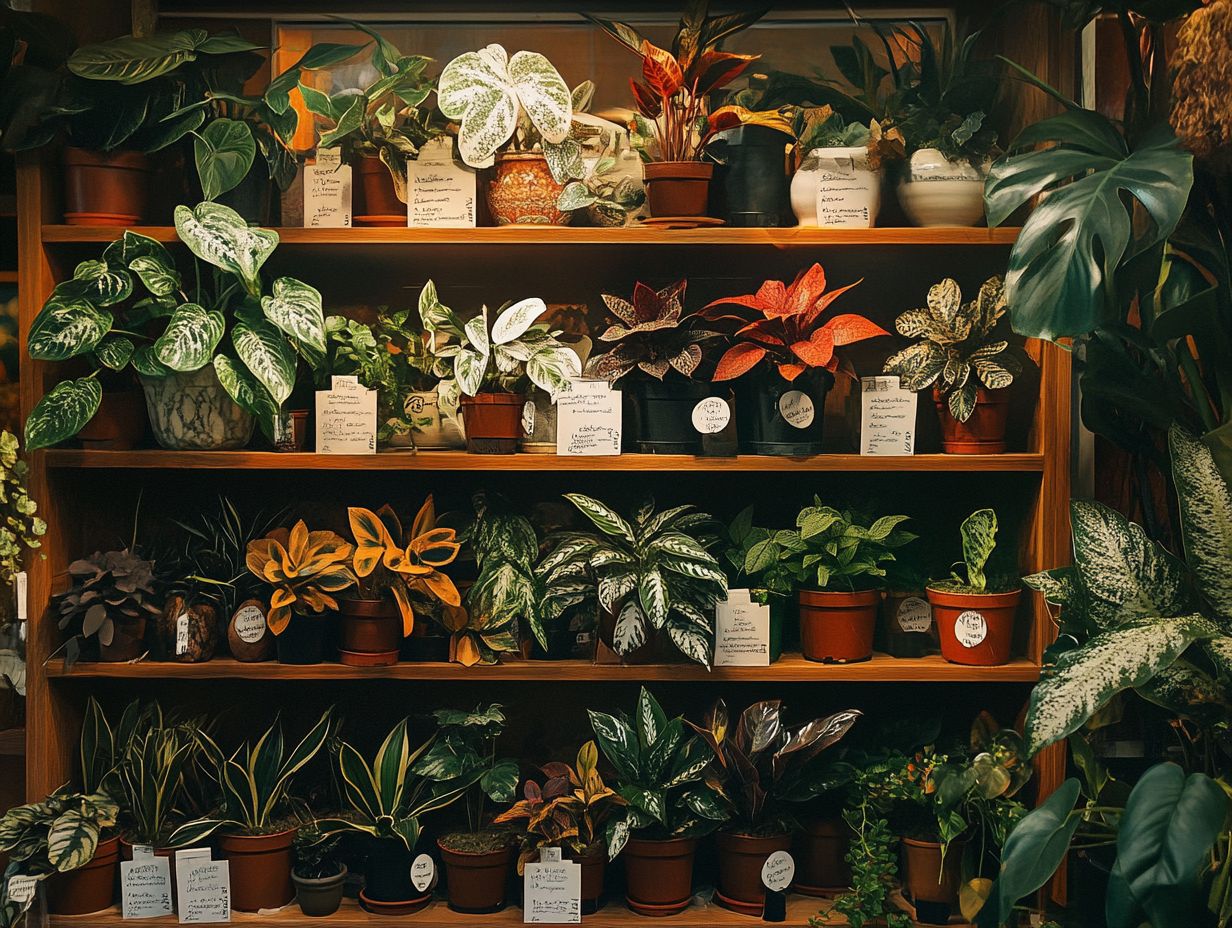
Leaf shape and size are essential indicators for identifying various houseplants, including succulents and foliage plants. They serve as your guide for selecting the ideal care regimen. For instance, the slender leaves of the spider plant stand in stark contrast to the broad leaves of the peace lily.
Each of these plants requires different types of care, including humidity levels. Understanding these traits is essential for your plants to thrive! Plants with thicker, glossy leaves, like the rubber plant, typically thrive in higher humidity. In contrast, those with smaller, more delicate leaves such as ferns prefer moderate moisture levels.
The variety of leaf shapes not only adds visual interest but also provides a practical framework for building your plant collection. Different shapes and sizes suggest distinct care strategies. By paying attention to these leaf traits, you can fine-tune your environment and ensure your green companions flourish.
Flower Color and Shape
Flower color and shape are essential elements in identifying flowering plants, elevating your indoor garden experience to new heights. Take the peace lily, for instance, with its elegant white flowers. This stands in striking contrast to the vibrant colors of many Christmas plants.
Each of these beauties requires specific care tips and conditions for optimal blooming. Grasping these characteristics is crucial for anyone looking to cultivate a diverse array of blossoms and learn effective pest control techniques.
Consider the bold reds and yellows of hibiscus; they captivate the eye and indicate a need for ample sunlight and consistent moisture, essential for thriving flowering species. On the other hand, orchids, with their delicate structure, demand a more nuanced approach. They require well-draining soil which allows excess water to escape, preventing root rot and humid environments, which are crucial for many unusual plants.
By observing the unique traits of each flowering plant, you can tailor your care routines, ensuring that every bloom flourishes during its flowering cycle and adds a vibrant splash of color to your space.
Identifying Indoor Plants by Care Needs
Identifying indoor plants according to their specific care needs is crucial for their health and longevity, especially for popular houseplants like the peace lily and snake plant. Each species comes with its own unique requirements for watering, temperature, and humidity.
Take, for instance, the peace lily, which flourishes in high humidity. In contrast, the ZZ plant shows remarkable resilience in drier conditions, showcasing the diversity of care required by different plant varieties.
This understanding allows you to create the perfect indoor environment tailored to each plant’s distinct preferences, including temperature control and humidity levels.
Watering and Fertilizing Requirements
Understanding the proper watering techniques and fertilizing requirements is essential for your plant care routine. These elements directly influence the health of your houseplants. For instance, the pothos thrives in consistently moist soil, while the snake plant prefers infrequent watering.
If you’re nurturing succulent plants or cacti types, letting the soil dry out completely between waterings is crucial to prevent root rot, which is when the roots decay due to excessive moisture. In contrast, tropical plants may need more frequent hydration because of their higher humidity needs.
A balanced, water-soluble fertilizer works wonders for most houseplants, ensuring their nutrient requirements are met. Apply it every four to six weeks during the growing season for optimal health. Heavy feeders, like peace lilies, thrive on a higher-nitrogen fertilizer, while cacti typically require little to no fertilization, especially during their dormant phase.
By customizing your watering and fertilizing routines to meet each plant’s unique requirements, you can create a thriving indoor garden filled with both common houseplants and unique species that showcase your green thumb! Additionally, being aware of how to identify common indoor plant pests will help you keep your plants healthy.
Temperature and Humidity Preferences
Temperature and humidity preferences play a pivotal role in the well-being of your indoor plants. They significantly influence their growth and appearance. Take the peace lily, for example; it flourishes in warm, humid environments, essential for many indoor palms and other tropical houseplants. Conversely, the spider plant adapts well to various temperatures but favors moderate humidity levels.
Understanding these preferences allows you to create a nurturing atmosphere for your leafy companions. Many indoor plants, like ferns and calatheas, love high humidity and need temperatures between 65 F to 75 F. This makes temperature control vital for their growth and overall health. Frequent misting or using a humidifier helps recreate their native tropical habitats.
In contrast, succulents and cacti thrive in drier, warmer conditions. They prefer lower humidity to prevent rot, even at cooler indoor temperatures. To maintain optimal conditions, regularly monitor temperature and humidity levels. Tailoring your care routines, like watering and fertilizing, to each plant s unique needs ensures they thrive under your care!
Resources for Identifying Indoor Plants

Accessing reliable resources for identifying indoor plants is crucial for both beginners and seasoned enthusiasts. These resources simplify understanding the care needs and characteristics of your green companions.
Online databases and apps, along with well-crafted books and guides, are invaluable tools for deepening your knowledge about popular houseplants and their distinctive features. They can also help you learn how to identify and treat soil of indoor plants.
Online Databases and Apps
Online databases and apps provide immediate access to essential information on plant identification and care for houseplants. They are critical resources for plant aficionados. Platforms curated by experts like Elyssa Goins allow you to easily input plant characteristics and receive comprehensive insights into various indoor species.
These resources often include diagnostic tools to help you identify issues like pests or diseases early on, ensuring the vitality of your greenery. For example, apps like PlantSnap and PictureThis let you upload a photo to receive instant feedback on the plant’s species, tailored care tips, and even customized watering schedules.
Many of these databases continuously update their information, providing timely advice grounded in the latest horticultural research. By leveraging these tools, you can cultivate a richer connection with your plants, enhancing your gardening experience while promoting sustainable practices!
Books and Guides
Books and guides are timeless treasures. They help you gain in-depth knowledge about plant care and identification for indoor plants.
These manuals cover a wide range of topics, from popular houseplants to rare varieties. This ensures you can cultivate your indoor garden with confidence.
They provide essential information about growing conditions, including light, water needs, and soil types. Titles like “The Houseplant Handbook” and “The Flower Gardener’s Bible” are excellent references that offer practical tips on pest control and growing new plants.
These resources also delve into seasonal care routines and troubleshooting common plant issues, enabling even the newest enthusiasts to thrive in their horticultural endeavors. Whether you’re nurturing a resilient succulent or a delicate fern, these guides are critical for creating a flourishing green space.
Frequently Asked Questions
How Do I Identify Indoor Plant Types?
There are several ways to identify indoor plant types. One option is to use a plant identification app that allows you to take a photo of the plant and receive information about it. Another option is to look up the plant’s characteristics, such as leaf shape and color, and compare them to reference guides or online resources.
What are some common characteristics to look for when identifying indoor plants?
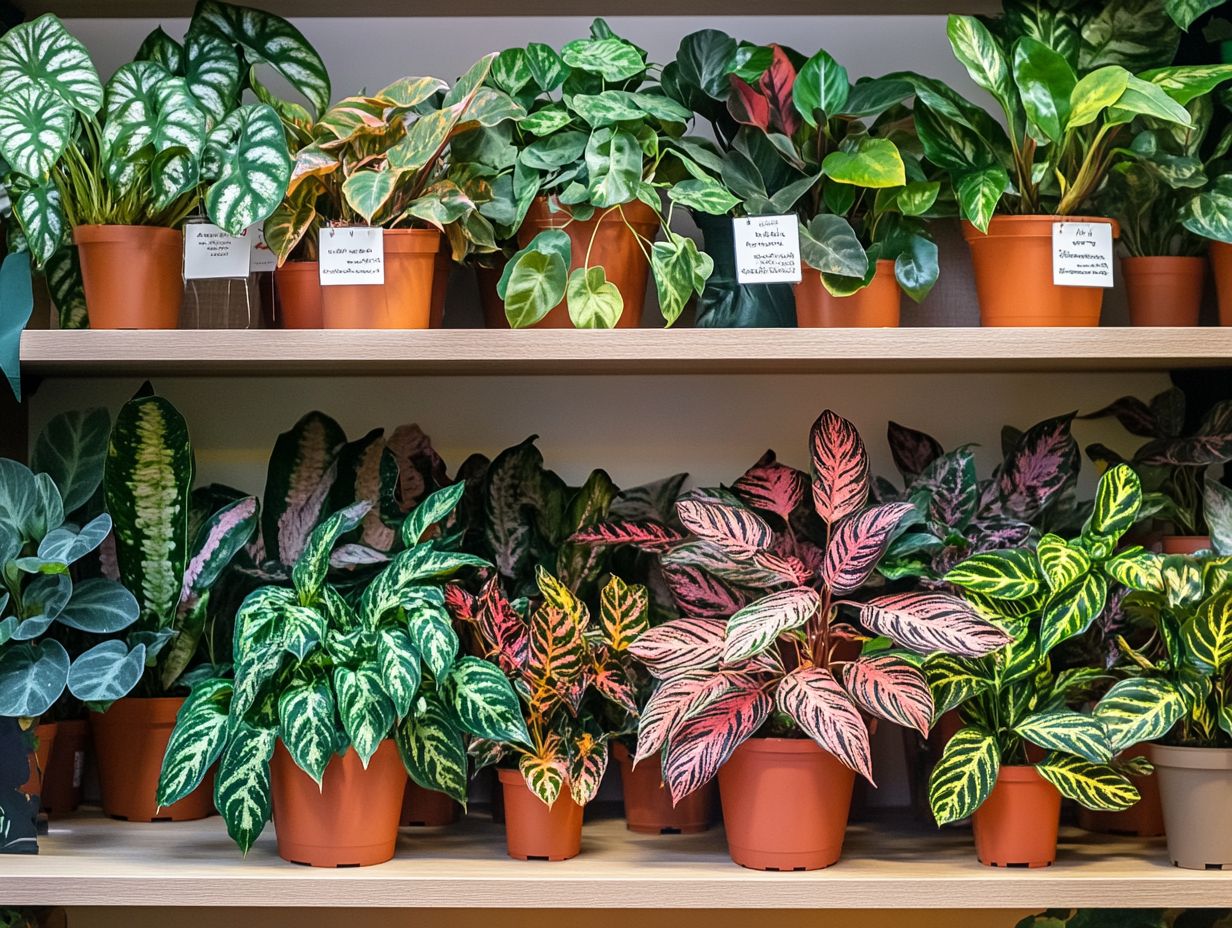
Common characteristics to look for include leaf shape, color and texture, stem structure, and overall growth pattern. The size and shape of the plant, as well as any unique features like flowers or fruits, can also help identify the plant type.
Can I identify indoor plant types based on their care needs?
Yes, in some cases. Some plant types have specific care needs that can help narrow down their identity. For example, succulents have thick, fleshy leaves and need minimal watering, while ferns have delicate fronds and require more humidity. However, not all plants have distinct care needs, so this method may not always be reliable.
Are there any tools or resources that can help me identify indoor plant types?
Yes, many resources are available to help identify indoor plant types. Besides plant identification apps and online resources, there are also plant identification books and guides. Local nurseries or plant shops often have knowledgeable staff who can assist with plant identification.
Why is it important to know the type of indoor plant I have?
Knowing the type of indoor plant you have is important for its proper care and maintenance. Different plant types have different needs, such as watering frequency, sunlight requirements, and fertilizing schedules. Identifying your plant can also help troubleshoot any issues, such as pests or diseases.
What should I do if I can’t identify my indoor plant?
If you are having difficulty identifying your indoor plant, don t hesitate to ask a plant expert for help. You can bring a photo or a sample of the plant to a local nursery or plant shop for assistance. Additionally, online forums and groups dedicated to plant identification allow you to post a photo and ask for help from other plant enthusiasts.

